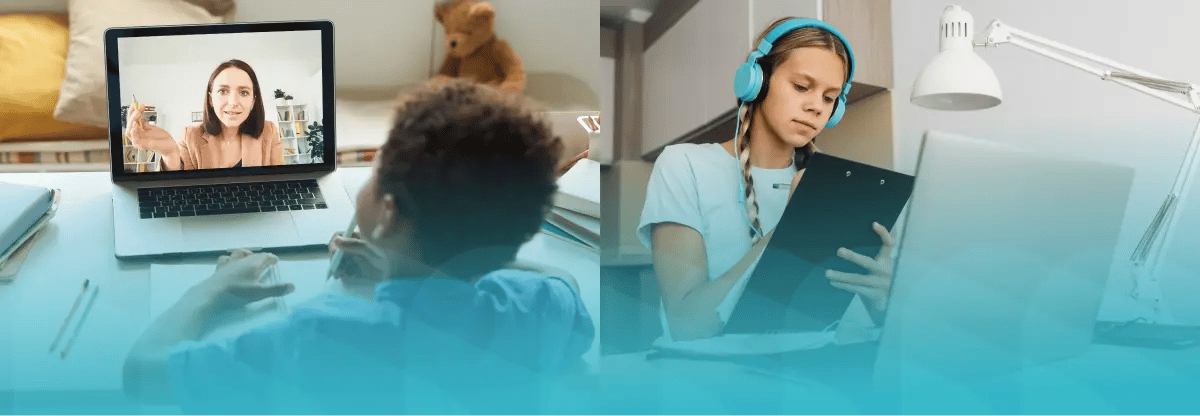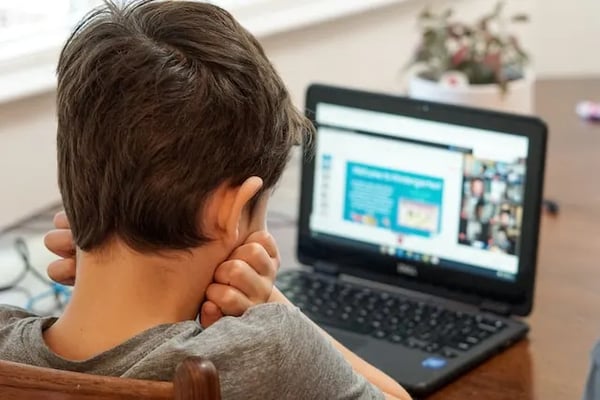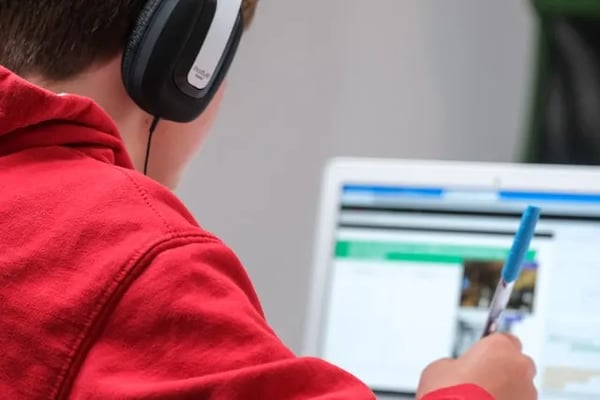
Digital tools are changing how learners access information and assignments. Still, finding the right blend of synchronous vs. asynchronous learning can be tricky for educators. Certain activities may lend themselves to one style or the other, but in some cases, a hybrid format works best. How do you make the right choice to satisfy your learning objectives and support learners?
Understanding the similarities and differences between synchronous vs asynchronous learning can help educators know when and how to use each learning format.
Let's explore further.
What is synchronous learning?
Synchronous learning refers to real-time instruction and discussion — like attending scheduled classes, interacting with teachers on video, or working on class projects. This is standard classroom learning, but it can be a bit more challenging in the age of technology.
Some students (no matter their age) find it difficult to stare at a screen for an extended time, and teachers need to adjust their instructional strategies to keep engagement high. For example, they might plan short lectures, followed by activities like debates or polls. Short breaks can also be built into synchronous sessions to keep students from getting restless.
Teachers deliver info-rich lessons and lead talks live, adapting to students' needs. Students ask questions and clarify as concepts come up. This quick back and forth between students and educators helps accelerate the learning process.
What is asynchronous learning?
Asynchronous refers to accessing materials at different times — like videos, discussion forums, and peer review work. This is self-paced. While there are deadlines for completing work, there’s no specific requirement for educators and learners to be in the same place, or to meet at the same time.
The key here is flexibility. Students control where/when they access materials, balancing learning and life. They can view content before discussions, complete assignments on their own time, and review concepts when they need a refresher.
However, with this freedom comes responsibility. Students need solid time management and self-motivation to stay on track. Additionally, learning in isolation can pose challenges for students who thrive on live peer interaction and support.

For teachers, lessons can be pre-planned, edited, or personalized based on learner needs. Various formats like audio and video make concepts accessible.
This also means instructional design is more important than ever. For example, a math teacher might post a set of practice problems online and provide a video tutorial with problem-solving techniques. Then, at their own pace, students can respond with a screen recorded video showing their work as they solve a problem. There’s still the back-and-forth between educator and learner, it’s just not done in real-time.
Synchronous vs. asynchronous learning similarities
Here are a few characteristics that synchronous and asynchronous learning have in common.
Knowledge acquisition
Both models focus on knowledge acquisition and helping students apply what they learn. The core learning experience revolves around meaningful engagement with course materials and connecting with peers.
Use of technology
Synchronous and asynchronous learning typically both incorporate technology. They require learners to have core digital literacy skills around operating devices, using applications, evaluating online sources, and engaging with content like videos or podcasts to complete coursework.
Assessment
Assessment and feedback loops are evident in both. Instructors assess student progress through assignments, quizzes, exams, or discussions. They may use one of the assessment styles or a mix of them to track progress.
Synchronous vs. asynchronous learning differences
As discussed above, there are also key differences between the two learning environments.
Scheduling
Synchronous learning happens in real-time, requiring students and teachers to be present together. Asynchronous learning is self-paced. As a result, it doesn’t have live interaction requirements.
Instructor involvement
Synchronous environments feature live instruction. Asynchronous rely more on self-directed learning and pre-made materials. Students use these materials to learn new concepts, and educators spend much of their time providing feedback.
Interaction
Synchronous learning enables real-time peer collaboration and discussion. Asynchronous uses tools like discussion boards for interaction. While students still connect, there’s more time between each interaction since they are typically self-directed.
Examples of synchronous vs. asynchronous learning
Thinking about how to use these learning styles in your own instruction? Here are some examples of synchronous vs asynchronous learning to get you started.
1. Live lectures - synchronous
Instructors show presentations and lectures on video conferencing platforms. Students attend virtually and can ask questions live using chat or audio features. All students engage with information at the same time.
2. Pre-recorded lectures - asynchronous
Instructors develop engaging lessons and video assignments covering course material. This gives students the ability to pause, rewind, and review concepts. That way, they can take greater control of their learning experience.
3. Office hours - synchronous
Teachers hold open office hour sessions that students can join as needed. This creates an environment for private or small group conversations to get personalized feedback, discuss grades, and address additional questions.

4. Online discussion boards - asynchronous
Classes may have ongoing forum-style conversations around discussion prompts. Students share perspectives over days or weeks. This can create space for more in-depth conversations than a traditional lesson allows.
5. Gamification - synchronous
Students come together in multiplayer game environments and complete collaborative challenges that reinforce curriculum concepts. For example, students might split into teams to compete in a trivia game. Instructors supervise these interactions and provide guidance through the experience.
Synchronous learning options like these create engaging spaces for students to gain knowledge together through immersive experiences. This supports the meaningful connections necessary to engage learners.
6. Self-paced online courses - asynchronous
Students work through a sequence of modules with assigned readings, videos, assignments, and assessments. There may be a deadline to complete the entire course, but students determine how quickly they move through the content.
With multimedia tools and interactive capabilities, instructors can put together courses and lessons for students to complete on their own time. All while maintaining the ability to assess each learner’s performance as they progress through the material.
Synchronous vs. asynchronous learning: How to choose the right method
When designing a course, determining what blend of synchronous and asynchronous learning will work best is crucial. There are many factors to consider when making this decision. Here’s what to keep in mind.
Course objectives and requirements
The outcomes that educators look for in different types of courses will impact where synchronous vs asynchronous learning comes into play. For example, subjects like math benefit from strong asynchronous components because they allow for lots of review. Humanities subjects like art and literature may benefit from more synchronous experiences where students can connect in real-time (although there are plenty of ways to turn traditionally writing-intensive courses into interactive online experiences.)
Educator strengths and bandwidth
Carefully consider your or your instructors’ skillsets, and how they can best benefit students. Synchronous sessions require more immediate engagement. This may be ideal for educators who thrive on that energy, but it can also be demanding. Asynchronous learning is more flexible, but educators need to focus on curation of materials and resources.
Student needs and preferences
Some learners thrive in live learning spaces while others appreciate the control of self-paced environments. When looking at synchronous vs asynchronous learning, consider student populations and goals. Study findings published in the Asian Association of Open Universities Journal show that the combination of synchronous learning and technology is sometimes stressful. It can more responsibility on students because of the increased screen time.
At the same time, asynchronous learning allows students to self-explore and research the topics assigned to them. Other students felt that asynchronous activities create a burden because of many written assignments to be submitted.
When thinking through synchronous vs asynchronous learning, educators must think about what their students prefer. For example, if educators go the asynchronous route, they may want to include a mix of discussion forums, audio, and video. If they go the synchronous route, teachers may want to think through incorporating interactive elements to boost engagement.
How to take a blended learning approach
Still not sure what to select in the synchronous vs asynchronous debate? Blended learning combines both synchronous and asynchronous experiences to enhance instruction. This maximizes the benefits of each format.
For example, chemistry students could review asynchronous video modules explaining formulas during the week and attend live virtual sessions at the end of the week to get answers to their questions. This is more in line with what learners want. Research from Anthology shows that over 80% of students now prefer that at least some of their courses or course meetings take place online.
A blended learning model provides the flexibility students need while still providing some level of structure. By combining self-paced lessons with live, interactive sessions, this format allows students to learn in the way that works best for them.
When they need to go at their own pace to grasp concepts, asynchronous materials are available. All while synchronous sessions provide the benefits that come with connecting with peers and instructors.
The possibilities of learning models are always evolving, thanks to technology making them more accessible to all. With some planning and creativity, educators don’t have to turn synchronous vs. asynchronous learning into an either/or choice. They can use digital tools and knowledge of their own students to provide the best learning experience possible, whether that’s synchronously, asynchronously, or both!